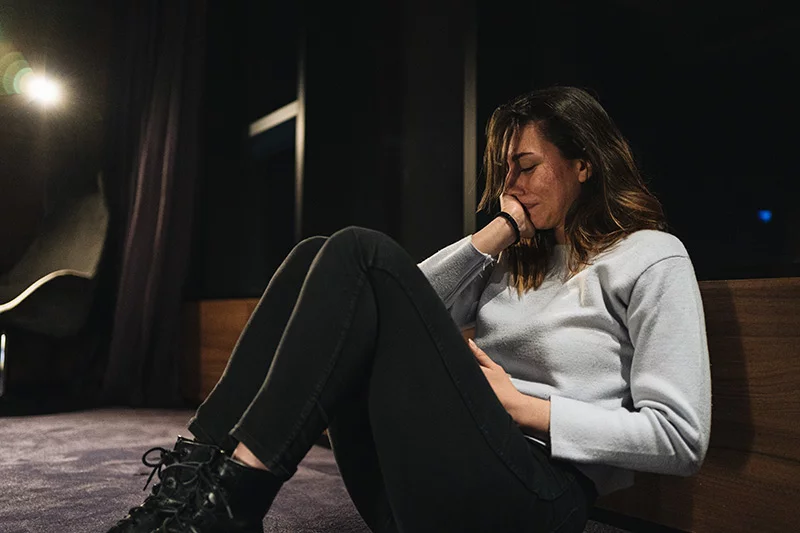
The pandemic has wreaked havoc on our mental health. Even the most resilient people are being challenged, but for those already suffering from mental illnesses, it has pushed them to their limits.
Symptoms of anxiety and depressive disorders increased considerably in the United States from April through June of 2020, compared with the same period in 2019, according to Centers for Disease Control and Prevention.
“Certainly behavior and mental health always has been an issue but with COVID, it’s exacerbated,” said Josie Rosenberg, a behavioral health counselor at UCHealth Mountain Crest Behavioral Health Center in Fort Collins and UCHealth’s coordinator for Zero Suicide in northern Colorado. “For adolescents, it’s been hard doing online school and not having access to their social circles and extracurricular activities. They are burned out and parents are burned out by having to support their kids and do their work at home. Everyone knows it’s been an incredibly difficult year. Substance abuse is more prevalent, and we know financial struggles and problems can be a real risk factor for suicide.”
One CDC study showed that during June 2020, 31% of U.S. adults reported anxiety or depression symptoms, 26% reported trauma or stressor-related disorder symptoms, and 11% seriously considered suicide.
Nationally, suicide by those ages 10-24 has been steadily increasing over the past decades — 57% between 2007 and 2018, according to the National Vital Statistics Report released in September 2020.
In January 2021, the Surgeon General released a call to action to implement the national strategy for suicide prevention.
UCHealth Today looked at what UCHealth and Colorado are doing to improve mental health services, and we asked our behavioral health care experts what you can do to keep loved ones safe when their options in life seem so narrow that they believe there is no other way out.
Understanding suicidal ideation
“It’s hopelessness — that’s the main link with suicide,” Rosenberg said. “When someone considers suicide, they have no cognitive flexibility — they are unable to see other options or possibilities. They are stuck and believe this is the only solution for problems, problems that could very likely be solved if they get help. But mentally, they are unable to see that.
“Treatment works with the patient collaboratively to solve those problems that are the drivers of that suicidal ideation so the person can see there are other options.”
As a community, Rosenberg said we need to talk about suicide, bringing awareness to the problem and acceptance for those in need of services. May — Mental Health Awareness Month — is as good of time as any to start.
“It’s important that our communities are involved and understand this is an issue,” she said. “These people already feel isolated, and not talking about this stuff, they will feel even more alone when they do have these thoughts, and that’s a dangerous thing.”
Suicide in Colorado
Even before the pandemic began, a record number — 1,287 — of Coloradans lost their lives to suicide in 2019. Historically, Colorado is in the top 10 states for death by suicide.
While mental health is a major risk factor, suicide is complex. Physical health challenges, lack of social support, access to lethal methods and situational causes like job loss also contribute to the risk, according to the Colorado Health Institute.
In September 2019, UCHealth announced it would dedicate more than $100 million for behavioral health care. Last year, UCHealth integrated behavioral health specialists into many of primary care offices so mental and behavioral health challenges could be addressed along with physical health. Patients may also consult with a psychiatrist via video through UCHealth’s Virtual Health Center. UCHealth has also committed to adding a new inpatient behavioral health unit at University of Colorado Hospital.
Four years ago, UCHealth Memorial Hospital participated in a study for Youth Suicide and Lethal Means Counseling. As a result, Memorial’s emergency room staff give trigger locks, gun safes and medication lock boxes to patients or family members as part of their “safety planning and lethal means counseling” during regular behavioral health evaluations in the ER or during hospital admission.
“Many suicidal crises last just 10 minutes and if someone has quick access to a weapon … with guns there is very little room to save their life,” said Andrea Wood, behavioral health manager for UCHealth in southern Colorado. “If we can get them or a family member to lock up that weapon, they gain that 10 minutes back. It slows down their process to give them time to think about their crisis.
“We are not talking about taking away guns, but reducing access until they are out of the crisis — that’s what this is about,” Wood said.
Another step UCHealth has taken recently is to agree to become a Zero Suicide Organization. In early 2021, UCHealth began training and educating employees about suicide prevention to help caregivers recognize suicidal ideology in patients, loved ones and coworkers.
What is a Zero Suicide Organization?
“The main piece and most important about being a Zero Suicide Organization is that it will close the gaps in the system,” said Wood, who has now passed on her Zero Suicide coordinator role to Robin Schawe. “We use to not ask about brain health but now we ask everyone and talk to everyone about it in hopes we open the door for those people who need help to walk through.”
This is done by using the Columbia-Suicide Severity Rating Scale. C-SSRS is an evidence-supported questionnaire used for suicide assessment. It asks straightforward questions, like, “Have you wished you were dead or that you’d go to sleep and never wake up?”
“We might all feel like not getting up sometimes in the morning, but when you get to the point of thinking vs. planning vs. taking actual steps to carry it out, the Columbia walks our nursing staff through those questions and then what steps they should take based on the patient’s risk level,” Wood said.
There are seven elements to the Zero Suicide program, from working on culture change at the leadership level to staff training and evaluating monthly progress for improvements to how care is transitioned to qualified people within the community.
The initiative already is producing promising results.
“Forensic and emergency nurses have shared stories where they’ve been able to identify and help someone with a plan and intent to commit suicide,” Wood said. “And we hear many, many times that if we hadn’t asked and they had left, they probably would have tried to end their life by suicide.
“When we started this, we thought patients would be frustrated by us asking, but instead, we are finding they appreciate us caring for their brain care along with their medical care.”
So, what can I do to help lessen suicide rates?
Talk about suicide and ask the uncomfortable questions
For the longest time, there was this idea that if you asked someone if they were thinking about suicide, then you’d be putting the idea in their mind — nothing is further from the truth, Rosenberg said.
“Always ask the question,” she said. “Directly asking someone if they are suicidal is one of the most helpful things that friends and family can do.”
It shows you care and then you can take the next steps to get them help.
“There are several good evidence-based treatments for suicide,” Rosenberg said. “It depends on the clinician, what they’ve been trained in and comfortable with, but it all treats suicidal ideation and behavior.”
If you or someone you know is considering suicide, contact National Suicide Prevention Lifeline at 800.273-8255 (TALK). In Colorado, call Colorado Crisis Services at 844.493.8255 (TALK) or text “TALK” to 38255. In an emergency, call 911.
You can also find behavioral health specialists and locations at uchealth.org/services/behavioral-health/
Be there for them and listen
Listen for mentions of such things as: “I can’t do it anymore.” “I’m sick of it.” “You won’t have to deal with me anymore.” These comments may be signs they’re considering suicide, Rosenberg said. If you notice these comments, ask if they are thinking about suicide. And if they say yes, get them treatment.
You may think suicide is something they’d never consider, but you only really know if you ask, she said.
“Suicidal thoughts are not that uncommon,” she added. “So to normalize that and get them treatment is important. Just be there for them, consistently.”
Don’t give up on them, she advised.
“Drop a note, stay in touch, keep texting, keep checking in on people even if they wish you away — stay there and continue to follow up and let them know you are there for them,” she continued. “Hold the hope for them even when they feel it’s completely hopeless. Be there to tell them it is not, that you are there for them and will be there with them.”
Not sure what to say or how to support a person in crisis?
Attending a suicide awareness course is a step toward community awareness and arm you with the tools to help identify someone in a crisis. These classes will give you the tools and build your confidence in reaching out to those in need.
QPR (question, persuade, refer) training information can be found at qprinstitute.com. In Colorado Springs, Pikes Peak Suicide Prevention provides QPR training. In northern Colorado, SummitStone Health Partners provides QPR training. The Mental Health Center of Denver provides Mental Health First Aid. And in metro Denver, the Jefferson Center offers QPR training.

Remove the “lethal” option
Nine out of 10 people who use a firearm to attempt suicide die. In Larimer County, 50% of deaths by suicide in 2019 were from gunshot wounds, according to the county’s coroner’s report. It’s a stagnant statistic, according to its report, 45-65% of deaths by suicide over the past five years have been from gunshot wounds. For juveniles, that five-year statistic is 36%.
In a new study by Colorado School of Public Health on the University of Colorado Anschutz Medical Campus, 20% of high school students said they have easy access to a handgun.
“Our findings highlight that it is relatively easy to access a handgun in Colorado for high school students. This finding, combined with the high prevalence of feeling sad or depressed and suicide attempts, is concerning for the safety of adolescents,” said lead author Ashley Brooks-Russell, assistant professor in the Colorado School of Public Health.
So, what can you do?
Make sure guns are in a locked location and not accessible to those who may be dealing with depression or other mental health conditions. Studies show that 90% of people who attempt suicide and live, don’t later die from suicide. By making sure they don’t have access to lethal means, you may be saving their life.
“For most people, suicide is circumstantial — it’s a moment that leads them to that place,” Rosenberg said. Don’t give them an option for that moment to be lethal.
Parents also should assure that all firearms are secured wherever their children might frequent, such as a friend’s house. Ask caregivers of your child’s friends, “Do you have a gun in the home and is it locked up?”
Building awareness about suicidal ideation
Keeping guns locked and unloaded is part of the effort of UCHealth’s partnership with law enforcement agencies and Imagine Zero in northern Colorado.
Together with the Juvenile Gun Safety Coalition, Imagine Zero has created a campaign entitled “It Only Takes a Moment” that offers gun safety tips and teen mental health awareness to increase public awareness that kids and teens know about guns in the home and might find them in a time of crisis.
For more information about the campaign or to find available community resources, visit the Juvenile Gun Safety Coalition website at larimer.org/gun-safety.
